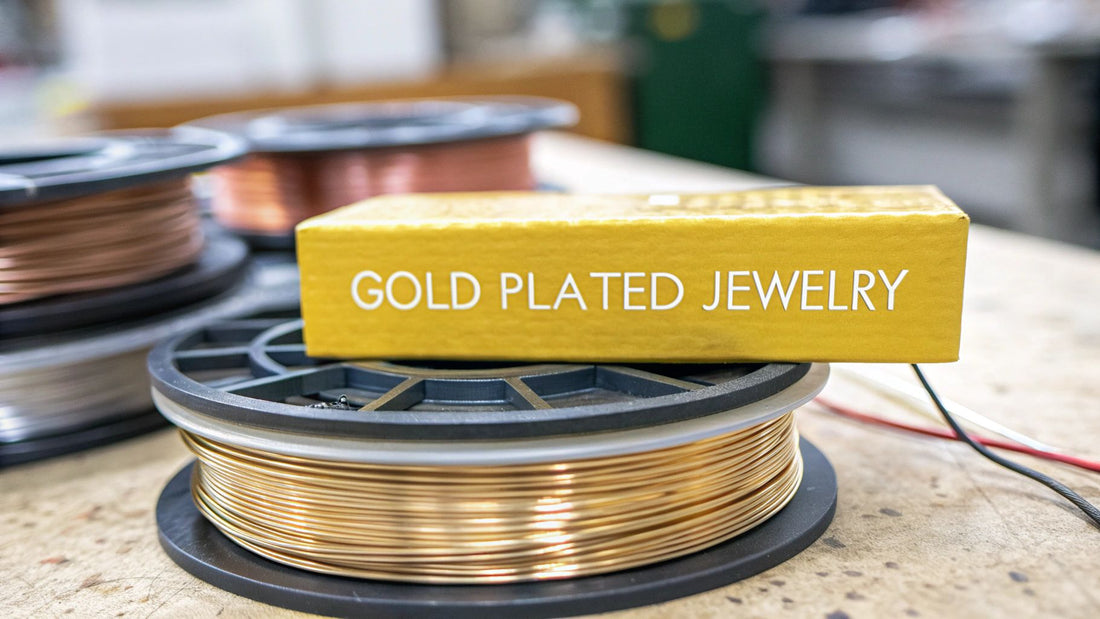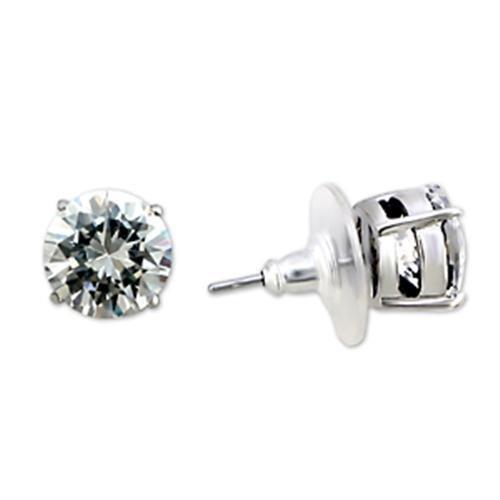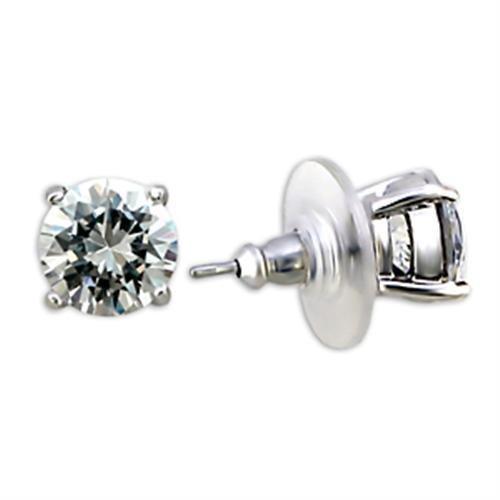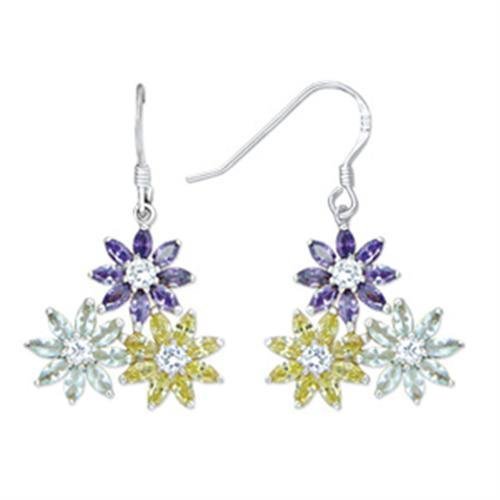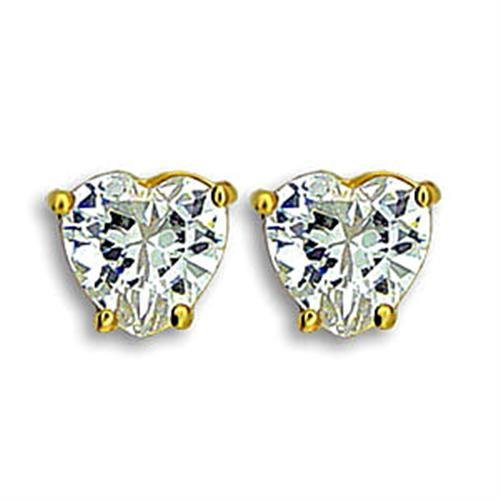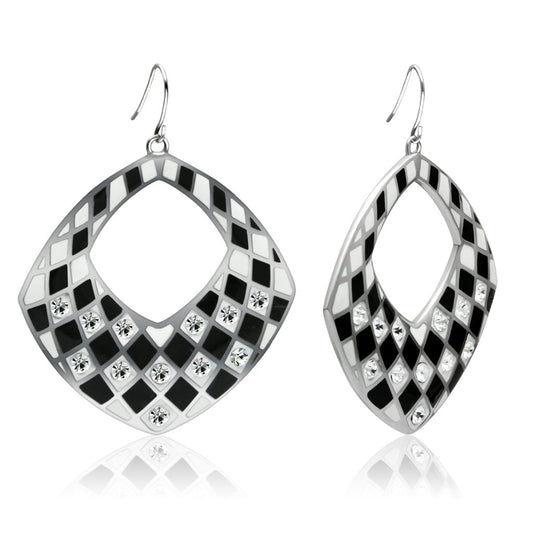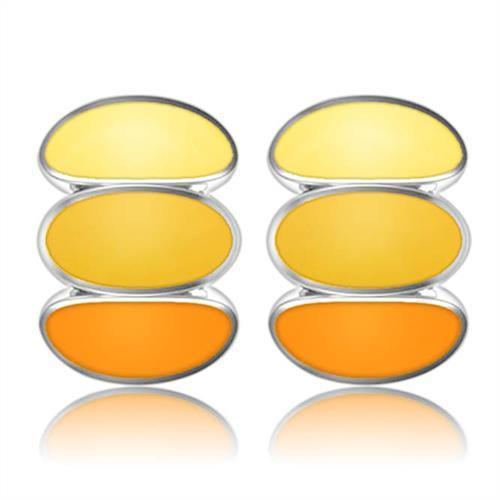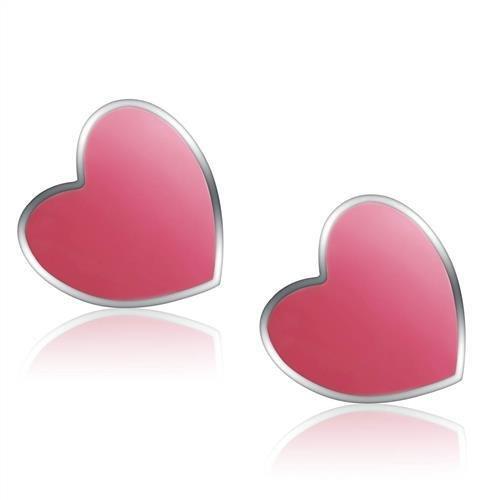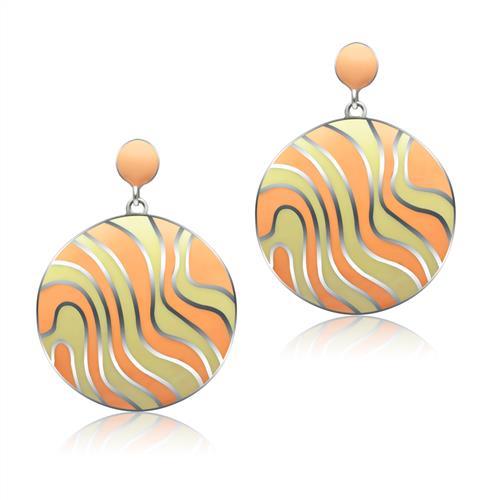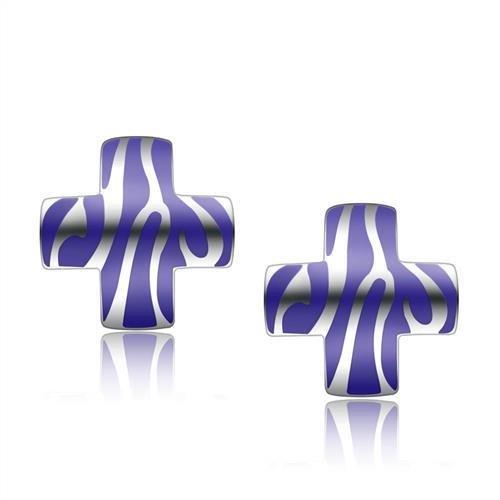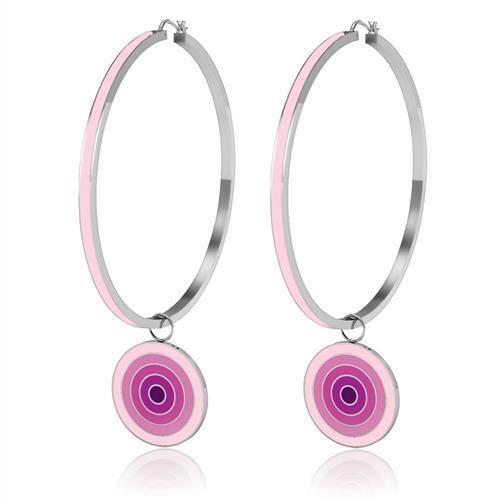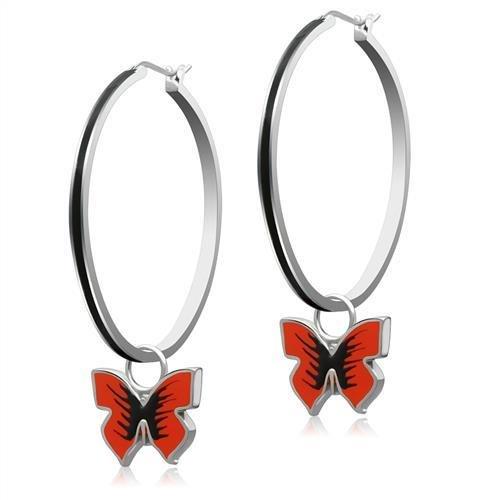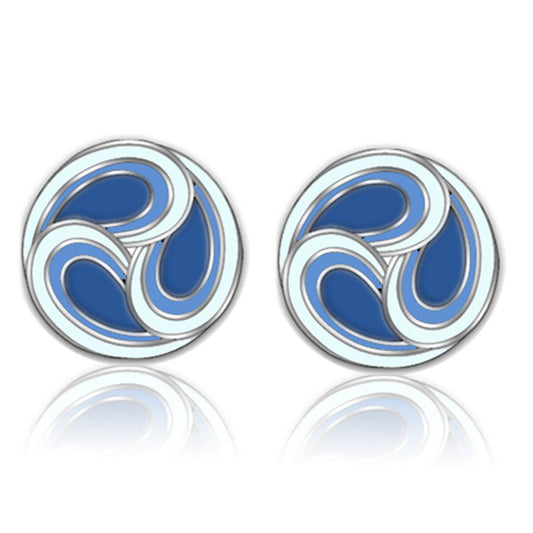Let's get straight to it. When we talk about gold-plated jewelry, we're talking about a piece where a thin layer of real gold is electrochemically bonded to a more affordable base metal, like brass or copper. So yes, the gold you see is authentic—the key difference is how much of it there is compared to a solid gold piece, which affects both its price and its durability.
What Exactly Is Gold Plated Jewelry?
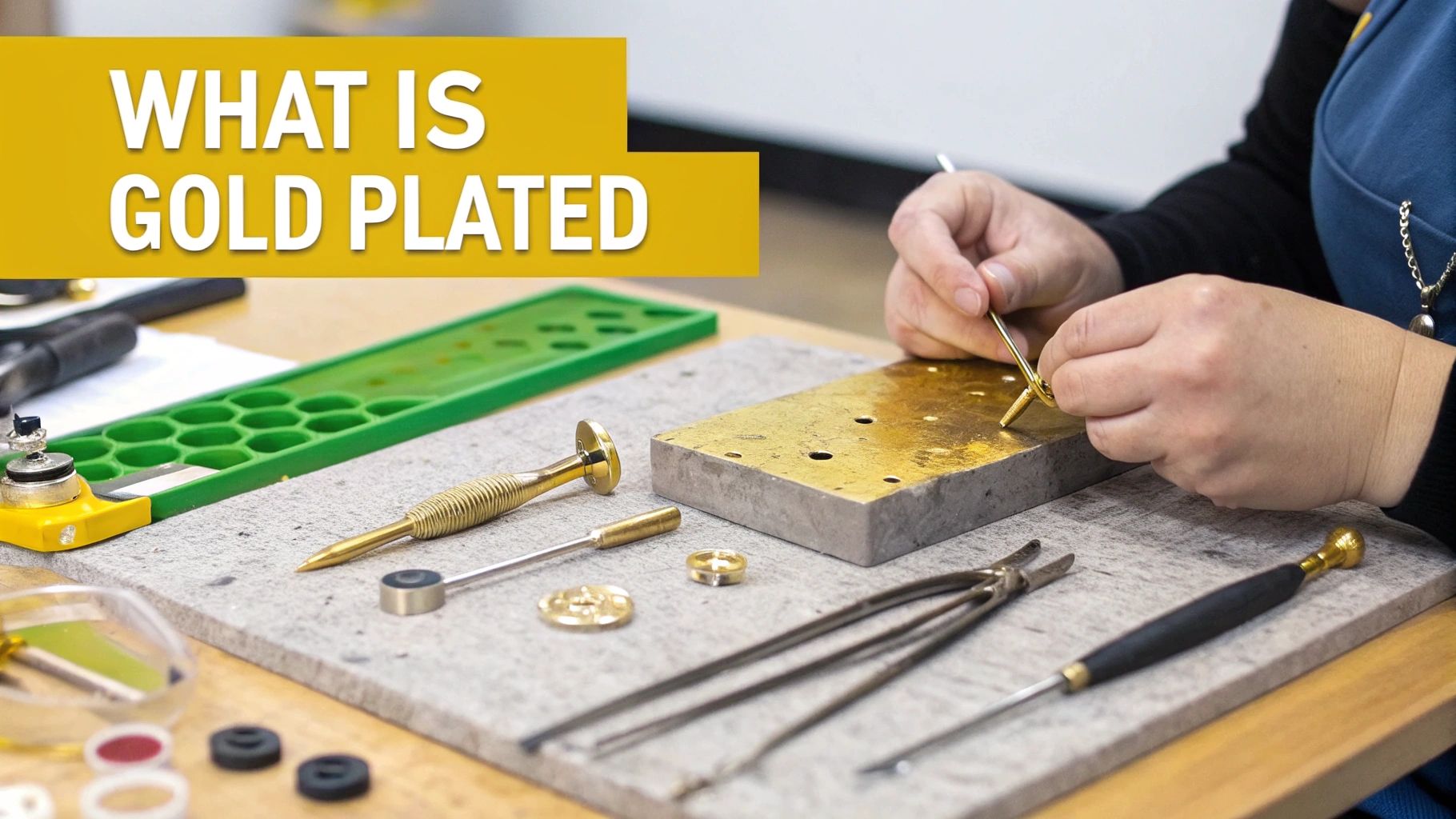
A great way to think about gold-plated jewelry is like a beautiful veneer on high-end furniture. You get the luxurious appearance and rich feel of a premium material—in this case, gold—without the much steeper price tag that comes with solid gold. It’s a clever layering technique that makes gorgeous, golden accessories accessible to just about everyone.
At the heart of a gold-plated item is a sturdy, less expensive metal. The most common choices are:
- Brass: A durable and reliable alloy made from copper and zinc.
- Copper: Known for its warm, reddish hue and excellent conductivity.
- Sterling Silver: When gold is plated over sterling silver, the piece is often called "gold vermeil"—a higher-quality category we'll explore a bit later.
This smart construction makes gold plating a fantastic, budget-friendly way to expand your jewelry collection. You can experiment with bold, trendy styles, grab a statement piece for a special night out, or build a versatile wardrobe of accessories for daily wear without a major financial commitment.
The real magic of gold-plated jewelry lies in its aesthetic appeal and affordability. It gives you the freedom to embrace new trends and express your personal style without breaking the bank.
So, when you ask what is gold plated, the answer is a brilliant combination of a precious metal exterior and a practical, sturdy interior. It's the perfect solution for the fashion-forward person who wants that Midas touch on a reasonable budget. Many of our stunning necklaces and earrings at Precious Pulse Jewelry use this very method to deliver high-end style you’ll absolutely love.
The Science Behind a Golden Shine

So, how does that perfect, gleaming layer of gold find its way onto a piece of jewelry? It all comes down to a fascinating scientific process called electroplating. Think of it as giving a piece of jewelry a carefully controlled, microscopic golden bath where science does all the heavy lifting. This precise technique is what turns an affordable base metal into a luxurious-looking accessory.
The journey starts with meticulous preparation. Before any gold is involved, the base metal—often something sturdy like brass or copper—has to be polished until it’s perfectly smooth and completely free of any dirt or oils. This pristine surface is essential to ensure the gold layer adheres flawlessly.
Electroplating is a method where an electric current persuades gold particles, suspended in a special solution, to form a thin, durable bond with another metal's surface. This creates the beautiful and uniform finish you see on gold-plated jewelry.
From Discovery to Modern Luxury
While the technique feels modern, the core principle behind electroplating actually dates back to the 19th century. What began as a scientific discovery has since been perfected, making what was once a complex process accessible for the affordable luxury we enjoy today. Historically, plating has always been a valued technique for combining gold’s timeless beauty with the strength of other metals.
Modern methods involve submerging the jewelry (the cathode) into a bath containing gold ions (the anode). An electrical current is then introduced, which coaxes those gold ions to bond evenly onto the object’s surface. This creates that seamless, even coat of gold. You can dive deeper into the history and the difference between plating types by reading about hard vs. soft gold plating insights.
This process gives jewelers incredible control over the final look and feel of a piece. A few key factors they can adjust include:
- Thickness: The longer an item stays in the golden solution, the thicker the gold layer becomes. This thickness is measured in microns (one-millionth of a meter) and is a big factor in both the durability and the cost of the final piece.
- Hardness: To make pieces tough enough for your daily style rotation, jewelers can add other metal alloys to the gold solution. This creates what's known as “hard” plating, which enhances durability without sacrificing that brilliant shine.
It's through this perfected technique that we can offer stunning, accessible pieces like our Brilliant Bauble Earrings that deliver that coveted golden glow without the solid gold price tag.
Plated vs. Vermeil vs. Solid Gold: Which Is Best for You?
Navigating the world of gold jewelry can feel like learning a new language. You'll hear terms like plated, vermeil, and solid gold thrown around, but understanding what they really mean is the key to becoming a smarter shopper. Think of them as different tiers of quality, with each one offering a unique mix of affordability, durability, and luxury. Let's break down which one best fits your needs.
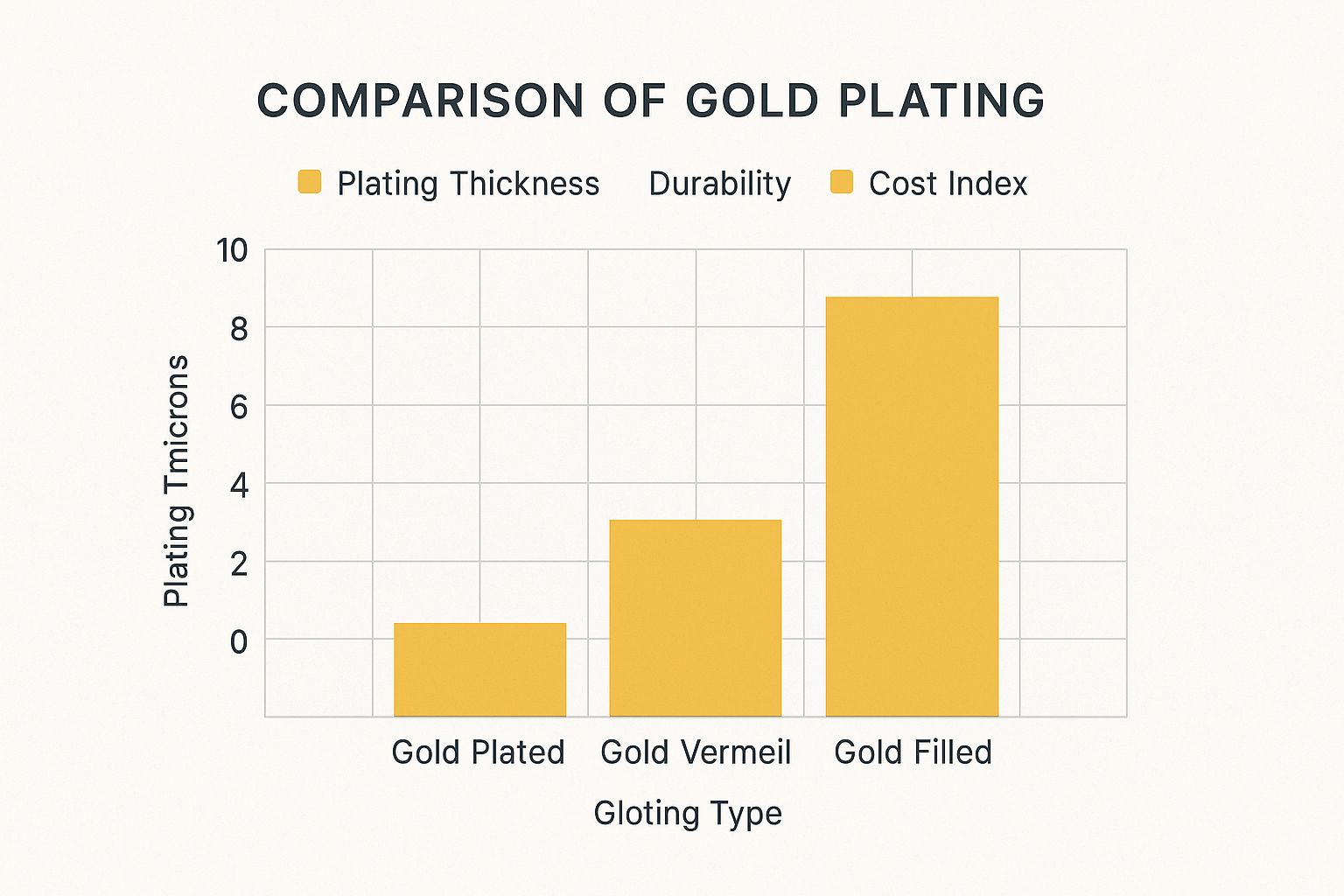
As you can see, there’s a direct link between the amount of gold, its durability, and what you’ll pay. More gold means more staying power—and a higher price tag.
A Practical Comparison of Your Gold Options
First up is standard gold-plated jewelry, which is the most accessible way to get that golden look. A thin layer of gold is electrically bonded to a base metal like brass or copper. It delivers that classic shine at a fantastic price, making it ideal for trendy pieces or accessories you won’t wear every single day.
Gold Vermeil (pronounced "ver-may") is the premium middle ground. To earn this title, a piece must have a thick layer of gold—at least 2.5 microns—plated over a high-quality sterling silver base. This makes it far more durable and hypoallergenic than standard plating, perfect for everyday luxury.
Finally, there’s solid gold. This is the ultimate lifetime investment. It's an alloy of pure gold mixed with other metals for strength, and its value and durability are simply unmatched. While it has the highest price tag, it will never tarnish or fade, making it the perfect choice for heirloom jewelry. For a deeper dive into its long-term value, check out our guide on if buying gold jewelry is a good investment.
Gold Jewelry Types: At a Glance
To make it even easier to choose, here’s a quick side-by-side comparison. This table breaks down everything from the metal at the core to what each type is best for.
| Attribute | Gold Plated | Gold Vermeil | Solid Gold |
|---|---|---|---|
| Base Metal | Brass, Copper, or other metals | Sterling Silver | Gold alloy |
| Gold Layer | Thin (typically 0.5-1.5 microns) | Thick (2.5+ microns) | N/A (Gold throughout) |
| Price Point | $ | $$ | $$$$ |
| Durability | Lower; requires more care | Higher; more resistant to wear | Highest; built for a lifetime |
| Best For | Trendy, affordable fashion | Everyday luxury, sensitive skin | Heirlooms, timeless investments |
Ultimately, choosing between plated, vermeil, and solid gold really comes down to what you need. By understanding this hierarchy, you can confidently pick the jewelry that fits your lifestyle and your budget perfectly.
Pros and Cons of Gold Plated Jewelry
So, is gold-plated jewelry the right move for you? Knowing what you're getting into—both the good and the bad—is the key to making a smart purchase. Let's take a balanced look at the benefits and drawbacks to see if it lines up with your style, budget, and what you expect from your jewelry.
The biggest win is obvious: affordability. Gold-plated pieces give you the freedom to build a fun, trendy jewelry collection without the eye-watering price tag of solid gold. You can play around with bold statement necklaces or seasonal earrings, like our Dazzling Drop Hoops, and always stay in sync with the latest styles. This makes them perfect for a specific event or just beefing up your accessory game.
The Trade-Offs to Consider
On the flip side, the major drawback is durability. Because that shimmering gold layer is quite thin, it's bound to wear down over time. This is especially true for high-contact pieces like rings and bracelets that are always rubbing against things. Once the gold wears away, the base metal underneath is exposed, which can lead to discoloration or tarnish.
Another thing to keep in mind is potential skin sensitivity. Many gold-plated items use base metals like copper or even nickel. If the gold layer fades, these metals can cause irritation for some people. If you have sensitive skin, it's super important to look for nickel-free options or maybe consider higher-quality alternatives like gold vermeil.
The real value of gold-plated jewelry is its fashion-forward flexibility. It’s built for seasonal enjoyment and trying out new looks, not for becoming a family heirloom. It offers the look of luxury for a fraction of the cost.
So, when you boil it all down, here are the key takeaways:
- Pros: Super affordable, perfect for experimenting with trends, and lets you build a big, varied collection without breaking the bank.
- Cons: Not as durable as solid gold, can tarnish over time, and might cause skin reactions if the base metal contains allergens like nickel.
By weighing these factors, you can go in with realistic expectations and decide if the trade-offs are worth it for your personal style.
Keeping Your Gold Plated Jewelry Like New
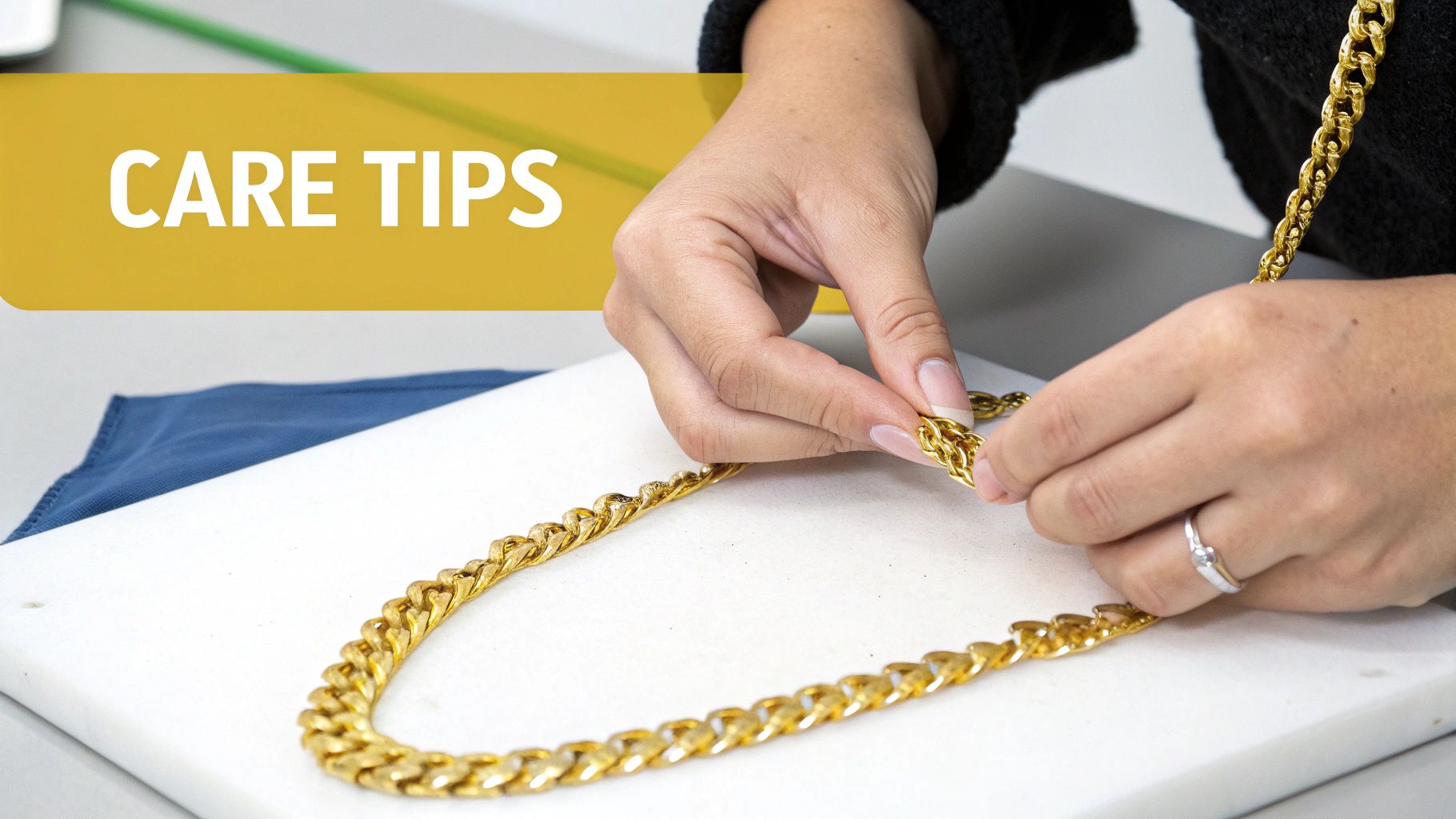
A little care goes a long way in preserving the brilliant luster of your favorite gold-plated accessories. With just a few simple habits, you can dramatically extend the life of your pieces and keep them shining bright. The secret is protecting that delicate gold layer from chemicals, moisture, and friction.
One of the most effective habits you can adopt is making your jewelry the last thing you put on and the first thing you take off. Always apply your lotions, perfumes, or hairspray before accessorizing to prevent chemical exposure, which can degrade the gold layer over time. This one small step can make a huge difference.
Water is another element to be cautious around. The chlorine in swimming pools and even the minerals in everyday tap water can be surprisingly harsh on plated finishes. If you're wondering about the specifics, we have a whole guide that answers the question: is it safe to wear a gold-plated necklace in the shower?
Best Practices for Cleaning and Storage
Proper cleaning and storage are your secret weapons against tarnish and scratches. Follow these simple tips to maintain that fresh-out-of-the-box glow and ensure your affordable treasures last as long as possible.
- Gentle Cleaning Only: The best method is a simple one. Use a soft, dry, lint-free cloth to gently wipe away any oils or dirt after each wear. For a deeper clean, a mix of warm water and a few drops of mild dish soap will do the trick, but always be sure to dry the piece completely and carefully afterward.
- Smart Storage: Never just toss your plated jewelry into a drawer with other items. That’s a recipe for scratches! Instead, store each piece in a separate soft pouch or a lined jewelry box to prevent the friction that can wear away the thin gold layer.
- Avoid Abrasives: Steer clear of harsh chemical cleaners, baking soda, and abrasive polishing cloths. These are far too aggressive and can easily strip the plating right off, exposing the base metal underneath and causing permanent damage.
By building these easy habits into your routine, you can keep your gold-plated jewelry looking absolutely fantastic.
Is Buying Gold Plated Jewelry a Smart Choice?
So, what's the final verdict on gold-plated jewelry? The truth is, deciding if it’s a smart choice is all about you—your style, your budget, and what you expect from a piece of jewelry. For a lot of people, it's the perfect solution.
Gold plating is an incredible way to get that luxurious, high-end look of gold without the hefty price tag. This makes it perfect for experimenting with new trends, grabbing an accessory for a special occasion, or just building a fun, versatile jewelry collection that won't drain your bank account. It might not be the piece you pass down for generations, but it’s a seriously savvy and stylish option for an ever-evolving wardrobe.
The 'worth' of gold-plated jewelry is a personal equation. It perfectly fits the needs of anyone prioritizing fashion flexibility and affordability over a lifetime investment.
A Fit for Modern Style
Ultimately, its value comes down to the role it plays in your life. While gold-plated jewelry isn't a financial investment like solid gold, it's a smart investment in your personal style. The global market for plating chemicals was valued at USD 523 million in 2024 and is projected to keep climbing, proving the enduring popularity of plated goods in fashion and beyond.
For the fashion-forward buyer, embracing well-crafted plated collections is simply a smart way to express yourself. It delivers the stunning look of more expensive metals—something you can dive deeper into in our guide on which is the most expensive between gold, silver, and diamonds.
Common Questions About Gold Plated Jewelry
Even after you've got the basics down, a few questions about gold-plated jewelry always seem to pop up. Let's clear up any lingering doubts with direct, practical answers so you can feel totally confident when you're shopping for or caring for your favorite pieces.
Does Gold Plated Jewelry Turn Your Skin Green?
This is probably the most-asked question, and the short answer is: the gold itself is not the problem. That harmless green tint on your skin happens when the thin gold layer wears away, exposing the base metal underneath—usually copper or a copper alloy like brass. When that metal reacts with your skin’s natural oils, sweat, and lotions, it can oxidize and leave a temporary green mark.
Practical Advice: To avoid this, look for pieces with thicker plating (like gold vermeil) or choose items from reputable brands that use higher-quality, less reactive base metals and are labeled as nickel-free. Proper care to protect the plating is also key.
How Long Does Gold Plating Last?
The lifespan of gold plating really comes down to three things: how thick the plating is, what type of jewelry it is, and how well you take care of it.
For a piece you only wear on special occasions, like earrings or a necklace, the plating can easily last for two years or even more. But for something you wear every day that sees a lot of friction, like a ring or bracelet, you might notice signs of wear in as little as six months to a year.
Practical Advice: A thicker plating—measured in microns—will always give you more mileage. When buying, ask about the plating thickness if possible. For daily-wear items, investing in gold vermeil (2.5+ microns) is a smart move.
Can You Get Jewelry Re-Plated?
Yes, you absolutely can! This is one of the best things about owning gold-plated jewelry. A professional jeweler can work some serious magic on a faded or worn piece. They'll strip off the old layer, polish the base metal until it's perfect, and then apply a fresh, brand-new coat of gold using the electroplating process.
Practical Advice: Re-plating is an incredibly cost-effective way to bring a beloved accessory back to its former glory. If you have a piece you love that's showing wear, contact a local jeweler to ask about their re-plating services and costs.
Is Gold Plated Jewelry Hypoallergenic?
This all boils down to what's underneath the gold. If the base metal contains nickel—a very common allergen—you could definitely have a reaction once that top layer of gold starts to wear down. Pure gold itself is hypoallergenic, but the plating and base metal are what matter here.
Practical Advice: If you have sensitive skin, it's crucial to look for pieces specifically labeled "nickel-free" or "hypoallergenic." An even safer bet is to choose gold vermeil, which always uses a sterling silver base (a much less common allergen) and is a great choice for sensitive skin.
Ready to find that perfect golden look without the solid gold price tag? The collection at Precious Pulse Jewelry is full of stunning, on-trend pieces designed to give you affordable luxury. Discover your next favorite necklace, earrings, or bracelet by visiting Precious Pulse Jewelry.

